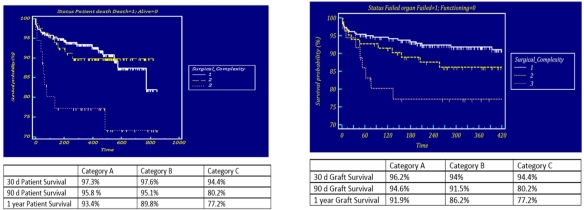Pre Liver Transplant (LT) Prediction of Surgical Complexity by Recipient Risk Grading and Optimizing Outcomes: The Ochsner Experience
1Multi-Organ Transplant Institute, Ochsner Health System, New Orleans, LA
2School of Medicine, University of Queensland, New Orleans, LA.
Meeting: 2018 American Transplant Congress
Abstract number: C231
Keywords: Graft survival, Liver transplantation
Session Information
Session Name: Poster Session C: Liver: Recipient Selection
Session Type: Poster Session
Date: Monday, June 4, 2018
Session Time: 6:00pm-7:00pm
 Presentation Time: 6:00pm-7:00pm
Presentation Time: 6:00pm-7:00pm
Location: Hall 4EF
Background: Ochsner Unit has been assigning the potential recipient with surgical complexity category since 2015 to preempt surgical risk .
Aim: To review outcomes after the implementation of a surgical complexity scoring system.
Methods: A retrospective review of 400 consecutive liver transplants between Jan 2015 -Dec 2016. Patients were stratified into: A (low risk, n=268), B (moderate risk, n=91), and C (high risk, n=41) categories. Cox regression was used to analyze factors associated with surgical risk. Subgroup analyses were performed. 
Results: Recipient BMI >30 (-HR 1.16; 95%CI 1.01-1.32), >5 Days of dialysis post-transplant (HR1.05; 95%CI 1.01-1.10), total surgery time (HR 2.90; 95%CI 1.13-7.73), low pRBC transfusion (HR-0.80; 95%CI 0.67-0.96), Low MELD (HR-0.69; 95%CI 0.57-0.84) and waitlist time (HR 0.99; 95%CI 0.98-0.99) were significant factors associated with graft survival.
High risk (C) recipients were likely to have longer ICU stay (p=0.02), longer surgical time (p=0.02). Low risk (A) recipients were likely to have higher DRI organ (p<0.001), macro-steatotic >10% (p=0.01) and micro-steatotic liver >10% (p=0.01). Incidence of EAD (–OR 0.53; 95%CI -0.25-1.130; p= 0.28) biliary complications (OR-0.71; 95%CI 0.37-1.31; p=0.51), HAS (OR- 0.49; 95%CI 0.22-1.11; p= 0.16) and HAT (OR 0.22; 95%CI NA; p= 0.24) were not significant across all complexity grades. The survival in high risk cohort was optimal at 30 d, 90 d and 1 Y post LT.  Conclusion: We have developed a novel system of recipient surgical complexity assessment. Prospective outcome measures show these distinct groups have different resource requirements.
Conclusion: We have developed a novel system of recipient surgical complexity assessment. Prospective outcome measures show these distinct groups have different resource requirements.
CITATION INFORMATION: Sharma H., Bohorquez H., Bruce D., Seal J., Cohen A., Bugeaud E., Carmody I., Sonnier D., Mathur A., Marroquin D., Voltz M., DeGregorio L., Loss G. Pre Liver Transplant (LT) Prediction of Surgical Complexity by Recipient Risk Grading and Optimizing Outcomes: The Ochsner Experience Am J Transplant. 2017;17 (suppl 3).
To cite this abstract in AMA style:
Sharma H, Bohorquez H, Bruce D, Seal J, Cohen A, Bugeaud E, Carmody I, Sonnier D, Mathur A, Marroquin D, Voltz M, DeGregorio L, Loss G. Pre Liver Transplant (LT) Prediction of Surgical Complexity by Recipient Risk Grading and Optimizing Outcomes: The Ochsner Experience [abstract]. https://atcmeetingabstracts.com/abstract/pre-liver-transplant-lt-prediction-of-surgical-complexity-by-recipient-risk-grading-and-optimizing-outcomes-the-ochsner-experience/. Accessed December 14, 2025.« Back to 2018 American Transplant Congress
